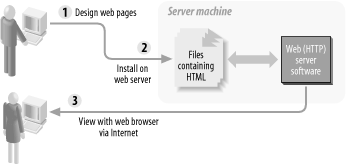4.1. Introduction to HTML
The World Wide Web was not invented by Oracle, Microsoft, IBM, Netscape, or any other software company. It was, in fact, created by a physicist at a laboratory in Switzerland, Tim Berners-Lee, who wanted a platform-neutral way for researchers around the world, already joined via the Internet, to share and link their work. Since improved communication, rather than commercial gain, motivated the Web's inventors, open standards rather than proprietary technologies are its lifeblood.
Even the language of the Web, HTML, one of a broad class of markup languages, is derived from a more mature open standard called Standard Generalized Markup Language , or SGML. The earlier standard is dense and complex. Fortunately for us, HTML is a lot simpler than SGML!
The fundamentals of HTML have not changed much over the years, and some readers may already be familiar with how to create web documents. If you understand the basics of HTML and web servers, including HTML forms, please skip ahead to Section 4.2. Otherwise, press on.
4.1.1. Where Do Web Pages Come From?
Imagine that you're sitting at your computer, looking at some web site on the screen. How did that page make its way to your desktop? There are three main parts of the process, as illustrated in Figure 4-1.
Figure 4-1. Web pages: from my office to your office

A web page designer somewhere had to make a ...
Get Learning Oracle PL/SQL now with the O’Reilly learning platform.
O’Reilly members experience books, live events, courses curated by job role, and more from O’Reilly and nearly 200 top publishers.

